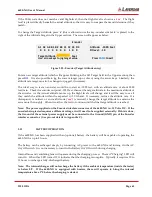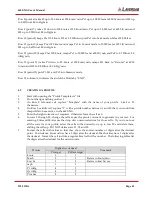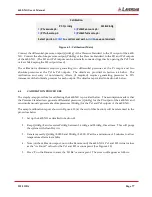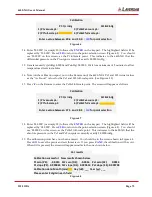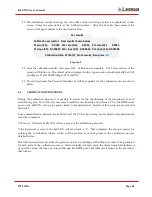
6600-NG User’s Manual
125-9110A
Page 73
SECTION 5 : TYPICAL USE
This section assumes that the user has read Section 3 and understood the functioning of the 6600-NG. Please
do not proceed without first reading Section 3.
Caution:
If the aircraft does not have any Ps2 ports then the Ps2 output of the tester must be capped-off.
Follow the procedure shown in Figure 5.1 below. This procedure should be used each time the tester is used
with an aircraft. The procedure allows the user to perform low-level leak checks to ensure that the adapters
and hoses are reasonably leak-tight.
Caution:
If the aircraft does not have any Ps2 ports and the Ps2 output of the tester is capped-off, then
before starting Step 4 of the procedure, it is important to change the Ps2 units to “Dfin” and set the Ps2
Target value to 0.0 Dfin.
Caution:
During your tests, do not put Pt, Ps2 or Ps1 in MEASURE mode unless the aircraft is at
“Ground”. Use only the Control and Leak modes.
During your test procedure, if you lose power, the 6600-NG will maintain the pressure. When power comes
back on, the 6600-NG and the aircraft will be at the same pressure as before except for pressure lost due to
leaks in the system.
If the 6600-NG behaves erratically for whatever reason, turn Off the 6600-NG using the Power key on the
Remote unit. Turn the unit back On after 30 seconds and attempt to use the 6600-NG again.
The 6600-NG is capable of overcoming substantial leaks in the system. It is not capable of overcoming
extremely large leaks. Therefore it is essential that the system be reasonably leak-tight before taking the
aircraft to higher altitude or airspeed.
During a leak-check if an excessive leak is detected, the 6600-NG will automatically put the outputs into
Control mode. An error message will indicate that a large leak exists. In such cases,
CANC
out of Leak
mode, go back to Ground and go through the leak-check process shown in Step 3 of the procedure in Figure
5.1, to find and fix the leak before proceeding further.
It may be helpful to keep a copy of the procedure, shown in Figure 5.1, with the 6600-NG to assist the
operator while using the 6600-NG.







